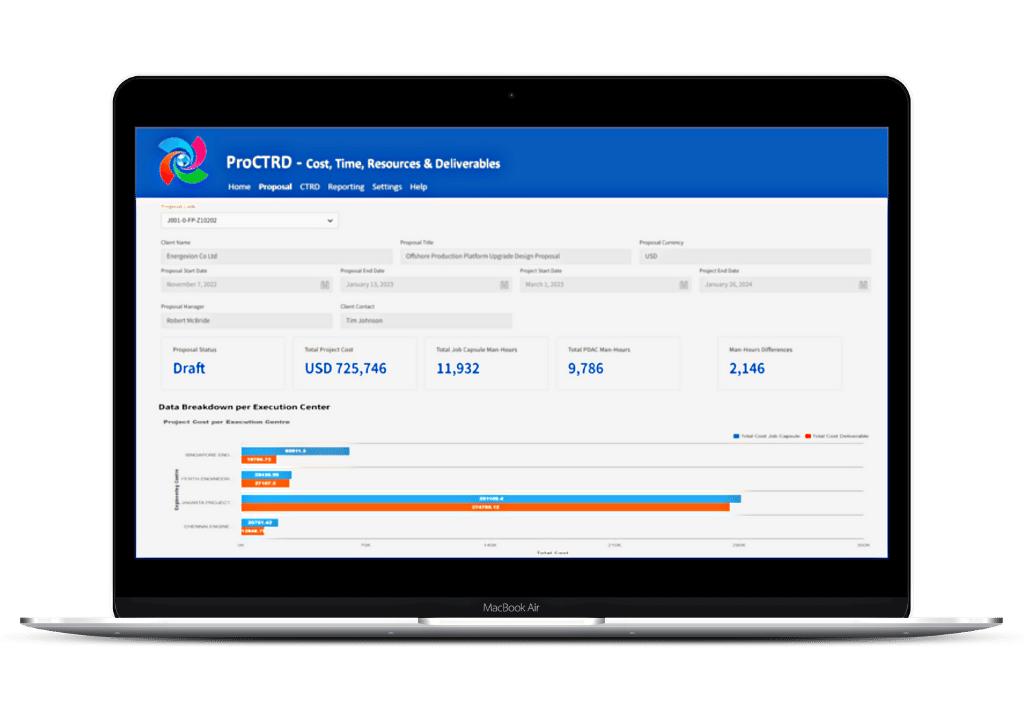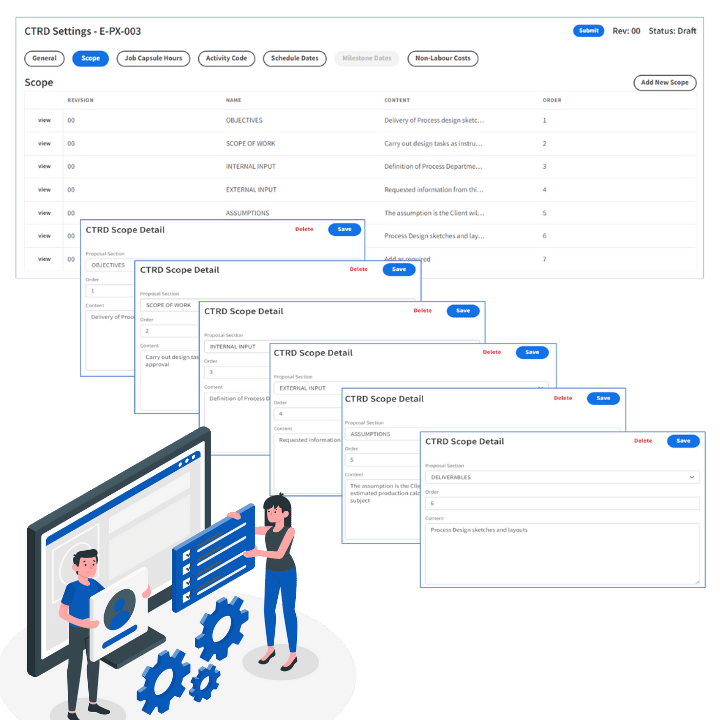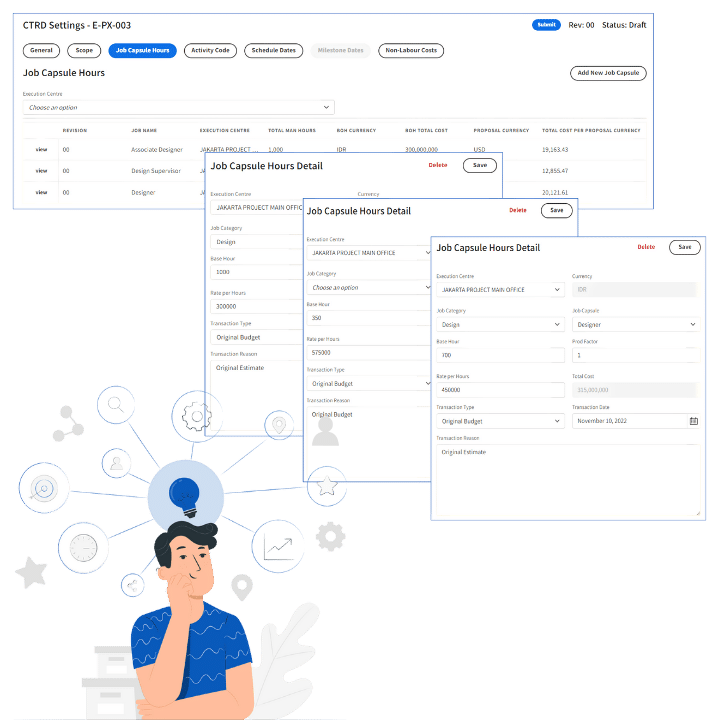ProCTRD
Proposal Development System
ProCTRD is a proposal development system designed specifically for managing and maintaining project proposals using structured hierarchies of discipline and job level capsules. Our system allows for easy tracking of manhour costs, deliverables, and execution centers, all identified against specific scopes of work on multiple cost, time, resources & deliverable (CTRD) outputs. With our detailed cost and manhour breakdowns, you can easily execute a defined scope of work. Contact us today to learn more about how ProCTRD can help streamline your proposal development process.

Why Choose ProCTRD

Proposal Type Flexibility
ProCTRD offers limitless project proposal types, making it ideal for industries with high volumes of proposals, such as engineering, construction, building services, and IT. Our system can help streamline the proposal submission and evaluation process, saving you time and reducing errors.

Library and Copy Function
Our multi-proposal full history capture provides the capability to increase your company’s proposal library over time. This allows employees to quickly access pre-existing content, replicate and adapt it to meet the requirements of a new proposal. This delivers multiple benefits, including time-saving, consistency, improved quality, cost savings, and knowledge management.

Proposal Template Definition
The proposal template definition function allows the security assigned User to define the sections and the ownership groupings to be used throughout the Proposal detailed level. Further functionality provides for proposal estimate capability at Discipline man-hours level or including a more granular view at Discipline deliverable level.

Multi-Location and Multi-Currency
ProCTRD offers multi-location and multi-currency execution, essential features for proposal software that provide multiple benefits to businesses. These include global reach, localized proposals, consistency, data analytics, currency exchange, high value, and cost savings. Proposal breakdown by execution location(s) assists in Discipline scope allocation based on skill sets.

Structured Role and Activity Conventions
Overall, structured role and activity conventions can assist in proposal development by clarifying responsibilities, standardizing content, facilitating communication, improving efficiency, and enhancing consistency. Clearly defined and structured activity-based deliverables ensure clarity of the estimates at the CTRD level. This can help to create proposals that are more competitive, compelling, and effective.

Multi-Level Graphical and Detailed Reporting
Predefined logic in ProCTRD links individual proposal CTRD records to job capsules, activities man-hours, rates, locations durations and costs in local currency. Our extensive graphical and tabular reporting provides a quick start use of the application. This can help proposal managers to plan resources more effectively, estimate costs more accurately, and allocate resources more efficiently.
Key Features






Proposal Template Efficiency
Time-saving
Creating proposals from scratch can be a time-consuming process, especially for industries where proposals follow a standard format. By saving proposals to a library, employees can quickly access pre-existing content and adapt it to meet the requirements of a new proposal, which can save time and resources.
Consistency
A proposal library can ensure consistency in the content and formatting of proposals across the company. This can help to build a strong brand identity and improve the company’s reputation for professionalism and quality.
Improved quality
Over time, as proposals are refined and updated based on feedback and new information, the library can become a repository of high-quality content. By reusing successful proposals, the company can increase its chances of winning new business and satisfying clients.
Cost savings
By reusing content from previous proposals, the company can avoid the costs associated with creating new content from scratch. This can be particularly beneficial for Engineering Companies where multiple Proposals over time may target similar scopes of work.
Knowledge management
The proposal library can serve as a repository of knowledge about the company’s strengths, capabilities, and previous successes. This information can be invaluable for employees who are creating new proposals or preparing for client meetings.
Multi Location and Multi Currency Capability
Global Reach
With multi-location capability, businesses can manage proposals from multiple offices and locations around the world. This can help to streamline the proposal creation and evaluation process, improve communication, and reduce errors.
Localized Proposals
With multi-currency capability, businesses can create proposals that are tailored to the specific needs of customers in different regions. This can include pricing, language, and cultural factors, which can help to improve customer satisfaction and increase sales.
Consistency
Multi-location and multi-currency capability can help to ensure consistency in the content and formatting of proposals across the organization. This can help to build a strong brand identity and improve the company’s reputation for professionalism and quality.
Cost savings
By managing proposals from a centralized location, businesses can reduce the costs associated with creating and managing proposals. This can include printing, shipping, and storage costs, as well as time spent on manual tasks.
Data Analytics
Multi-location and multi-currency capability can provide businesses with valuable data analytics that can help to improve their proposal process. This can include information on proposal success rates, pricing trends, and customer preferences, which can help businesses to refine their proposals and win more business.
Structured Role and Activity Heirarchy
Clarifying responsibilities
Structured role definition can help to clarify the roles and responsibilities of team members involved in the proposal process. This can ensure that everyone understands their role and can work together efficiently to complete the proposal.
Standardizing content
Activity structure can help to standardize the content of proposals, ensuring that they are comprehensive and include all necessary information. This can help to improve the quality of proposals and make them more competitive.
Facilitating communication
Structured activities can help to facilitate communication between team members and stakeholders involved in the proposal process. This can include setting up regular meetings or establishing protocols for exchanging information.
Improving efficiency
By providing clear guidelines for the proposal process and section ownership can help to improve efficiency and reduce the time and resources required to complete a proposal.
Enhancing consistency
Consistency is key to creating a strong brand identity and reputation. By using structured role and activity conventions, proposals can be consistent in their formatting, tone, and content, which can improve the company’s reputation and make proposals more effective.
Job Capsule Manhour Linking
Improved Resource Planning
Job capsule manhours linking provides a comprehensive view of the resources required for a particular job. This allows project managers to better plan their resources, including the number of people needed, their skills, and the amount of time required for the job.
Better Cost Estimation
Job capsule manhours linking also enables project managers to estimate the cost of a project more accurately. By linking categories, roles, locations, rates, durations, and costs, project managers can get a clear understanding of the total cost of a project and the cost of individual tasks.
Efficient Resource Allocation
Job capsule manhours linking allows project managers to allocate resources more efficiently. With a clear understanding of the resources required for each task, project managers can assign tasks to the right people and ensure that the workload is balanced.
Improved Reporting
Job capsule manhours linking also enables better reporting. By linking categories, roles, locations, rates, durations, and costs, project managers can create detailed reports on the progress of a project. This helps them to identify any issues that may be impacting the project and take corrective action.
Local Currency Conversion
Linking manhours, rates, and cost in local currency makes it easier to report financial data to stakeholders who are familiar with local currencies. It also makes it easier to compare costs across different locations and projects.
Activity Manhour Linking to Discipline Manhour Estimates
More Accurate Estimating
Linking activity level task estimating to discipline role manhour estimates provides a more accurate estimate of the time required to complete each task. This is because it takes account of the specific skills and expertise required for each task and the amount of time it will take each discipline role to complete it.
Improved Resource Allocation
By linking activity level task estimating to discipline role manhour estimates, project managers can allocate resources more efficiently. This ensures that the right people are assigned to the right tasks and that workload is balanced across the project team.
Enhanced Schedule Management
With accurate estimates of the time required for each task, project managers can create more realistic project schedules. This helps to avoid delays and assists Project Management in planning Project completion as efficiently as possible.
Better Cost Control
Linking activity level task estimating to discipline role manhour estimates also enables better cost control. By understanding the time required for each task, project managers can estimate the cost of the project more accurately and ensure that the project stays within budget.
Improved Communication
Linking activity level task estimating to discipline role manhour estimates provides a common language for the project team. This makes it easier to communicate about project requirements, resource needs, and schedule expectations.
Graphical and Tabular Reporting
Real-time Data
The reporting feature provides real-time data that is updated as soon as changes are made to the proposal. This allows users to monitor the progress of their proposal and make data-driven decisions based on proposal and activity schedule information.
CTRD Summary Reporting
This report provides Discipline level manhour allocation based on defined roles with a breakdown per discipline and summarized total manhour quantity.
Manpower “S” Curve
The Project “S” curve report is another live report developed from cumulative allocated activity manhours per week extended over the Project duration.
Manpower Histogram (Discipline)
The Manpower Discipline Histogram report is generated dynamically based on discipline manhour loadings displayed weekly over the Project duration.
Manpower Histogram (Discipline Group)
The Manpower Discipline Group report is generated dynamically based on discipline group manhour loadings displayed weekly over the Project duration.
CTRD Summary (Hire Location & Discipline)
The CTRD Summary report provides detailed information related to job capsule manhour allocation by discipline by Project execution location.
CTRD Definition Sheet
The CTRD Definition sheet is a ProCTRD output form which provides a breakdown of Scope, Deliverables, Discipline Roles and Costs for a specific activity and can be used in the collation and submission of the Proposal.
Interested in ProCTRD?
We would love to see if ProCTRD is a good fit for your company. Please fill out the form below and we will be in touch shortly to schedule a demo.






